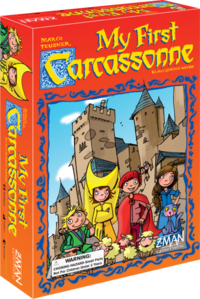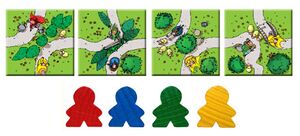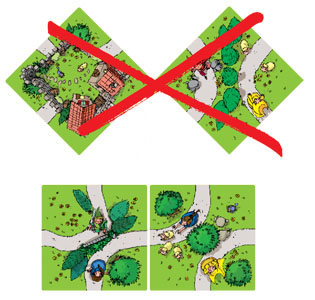Difference between revisions of "My First Carcassonne Base Game"
| Line 60: | Line 60: | ||
If a part of a closed road has a colour that no player is using, nothing is played on that part. | If a part of a closed road has a colour that no player is using, nothing is played on that part. | ||
[[File:Junior_PlaceFollower.jpg|frame|none|In the upper example the tile shown is part of a completed road. {{ColorRed|red}} places a follower on the closed road (A). | |||
The lower image shows an example of a road that is not yet closed (B) and one that is closed at both ends by buildings (C).]] | |||
</onlyinclude> | </onlyinclude> | ||
Revision as of 22:26, 16 February 2021
Main Page > My First Carcassonne > My First Carcassonne Base Game
| Each year, the people of France celebrate a national holiday on July 14th. In Carcassonne, the people mark the day by releasing the sheep, chickens and cows from their pens. All day, the children of Carcassonne make great fun by trying to catch the animals and return them to their pens by dusk. |
First published by Hans im Glück in 2009 under the name Die Kinder von Carcassonne, and initially translated into English as The Kids of Carcassonne (RGG 2009). It was renamed My First Carcassonne for the first ZMG release in 2014. It is known as Carcassonne: Junior in most non-English versions.
A second ZMG design, with revised artwork, was released in 2020 along with updated releases in most markets.
A fun and exciting tile-laying game for 2–4 players aged 4 and up from Marco Teubner. This is a children‘s version of the Carcassonne game from Klaus-Jürgen Wrede.
Contents
- 36 landscape tiles, about twice the size of normal Carcassonne tiles
- 32 game figures (8 in each color), larger than meeples from Carcassonne
Preparation
Take all landscape tiles, shuffle them, and stack them in several stacks around the table, so that each player can reach one or two stacks
Leave the middle of the table clear for this is where you will place the landscape tiles to build the map.
Each player chooses a colour and takes the 8 figures of that colour, placing them in their play area (the area in front of them on the table). With fewer than 4 players, remove the figures in the unchosen colors from the game.
Take one tile from a stack and place it face up in the center of the table to start the game. From this tile, the players will build the whole map of the game.
Aim of the Game
In the game, the players place tiles on the table to form a map. The first player to place all of their figures on the map wins the game.
Playing the Game
The players take turns in clockwise order, beginning with the starting player, who is chosen at random.
Placing a Tile
On each player's turn, first turn over the top-most tile from any stack and place it on the table, adding it to the map you are creating. The player must place the card so at least one edge lies against the edge of a tile previously placed on the map.
A tile may not be placed so that it touches another only at a corner.
Placing a Follower
On the roads (on each of the tiles), there are pictures of children in the four figure colours.
Whenever a player places a tile so that the road is closed at both ends, the players whose colours are shown on parts of the closed road, place their figures on these parts. Each road part with the colour of a player in the game gets a figure of that color. A road is closed if it ends, at both ends, at a pond, a wall, a house, or a green area.
A road is also closed when it forms a complete loop.
If a part of a closed road has a colour that no player is using, nothing is played on that part.
Footnotes
For Icons explanation and licensing please visit Icons page.


